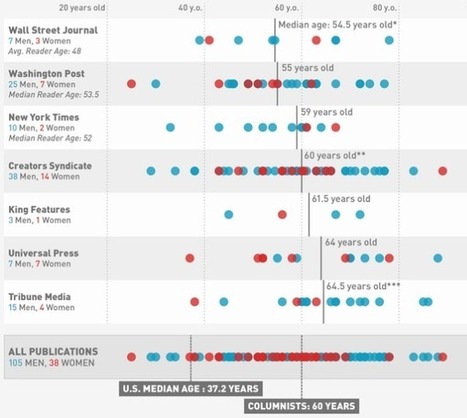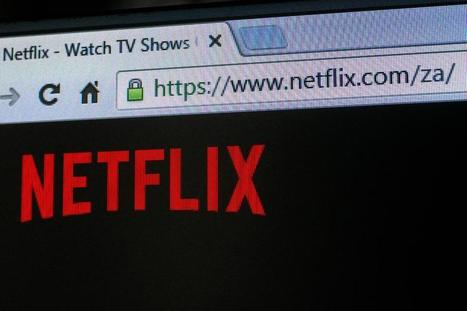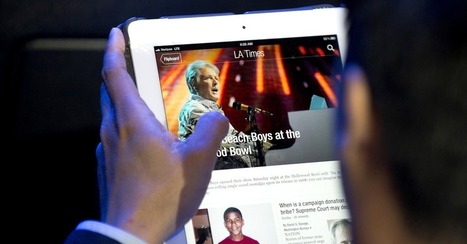 Your new post is loading...
 Your new post is loading...
Newsrooms are posting more of their content directly to social media platforms, but with little idea of what the rewards will be.
That insight comes from data presented by researchers at the Tow Center for Digital Journalism at Columbia University last week at a half-day event, “Digital News in a Distributed Environment.” Researchers surveyed more than 40 journalists and news media executives, from both national and local brands, as well as eight executives from Facebook, Twitter, Instagram, Google and Snapchat. They also held a roundtable attended by fifteen social media and audience editors. They found that a publisher’s business model is what determines its social media strategy – and no one solution works, said Claire Wardle, the research director at the Tow Center. While some publishers are optimistic about the new opportunities that social media provides, others feel powerless. And relationships between publishers and platforms are not always amicable, with one respondent referring to a platform as a “frenemy.”...
It sometimes looks as if the hyperlocal space is owned by commercial “pureplays” – the Yelps, Angie’s Lists and Weddings.com. These are the sites that most often seem connected to their often very vertical communities – and pull in the revenue, as documented in the new Borrell report. News sites grind out their duty coverage of local arrests, fires and traffic snarls, but how often do they capture what’s special about their towns and stir up communal sprit? And even if they do achieve that, how often do they reap new revenue from their enterprise? 30A succeeds at both. Founder and CEO Mike Ragsdale sees 30A as far more than a website. “It’s a network, it’s a brand,” he says. 30A has plenty of new about the Santa Rosa Beach communities along the Gulf Coast of Northwest Florida, including the occasional story that might not sit that well with visitors who reach for too many cool ones (“Spring Break Safety: Sheriff, Seaside Take Stand Against Illegal Activities”) But it’s also three retail stores, 30A Radio, 30A Weddings.com and 30A VideoTours.com, and more....
Ozy, Refinery29, Business Insider, Vox, and Buzzfeed are among the news and media startups valued over $100M.
Venture capital and strategic investors ranging from Comcast to Time Warner to Bertelsmann poured nearly $800M into digital news and media startups last year. The huge fundings are leading to some very robust valuations in the content business.
Notably, Buzzfeed and Vox Media each took investments of $200M from NBC Universal earlier this year, placing them in the now 139-member strong unicorn club. Now, Axel Springer has acquired Business Insider, valuing the company at $442M just 7 years after launch....
Instead, it’s perhaps a warning to anyone taking VC. You’d better expect if you’re taking all that money, you have a plan so the VCs get a pay-off. Are you going to generate those millions invested and more so? Or do you really think someone’s going to buy you for absurd multiples based on potential value? If so, maybe the VC money makes sense. But just because some publications go that route, not all need to.
Let me conclude by saying again how sad I am to see GigaOm end so suddenly. I hope the journalists there quickly find new places to write, as I’m sure they will. I also debated writing anything about this at all, when the loss of GigaOm remains so personal to so many and is still being digested. But seeing others writing about what it all means in the grand scheme of publishing, I thought another perspective might be useful.
It's an eye-opening report that looks beyond the hype surrounding these companies. Some of them are profitable (or at least claim to be), some aren't, but all of them have raised serious cash from starry-eyed investors (e.g., $96.3 million for BuzzFeed, $110 million for Vox).
The business press tends to regard such hefty sums as implicit evidence of success and/or promise -- why would venture capitalists risk so much scratch if there was no there there? -- but Michael reminds us that all of these companies rely, somewhat harrowingly, on advertising for revenue....
Newspapers were at the center of many free speech and access-to-information battles of the last century, but those days are all but done. Most newspapers are a husk of their former selves, and their legal budgets are as desiccated as the classified ad sections that once made them rich.
This raises the question of who will fund high-stakes public interest battles instead. Will it be the tech giants, like Google and Twitter, whose platforms have largely supplanted the newspapers as a daily source of information? Or does the tech industry’s fixation with growth and data control preclude it from truly taking up the public interest torch?...
Last July, The Washington Post launched a live video channel that its president proclaimed would be “the ESPN of politics.” Instead, PostTV turned out to be more like a public access show. Within five months, the live content had vanished and the “channel” became little more than a clearinghouse for pre-taped video packages and recycled press briefing footage, along with the occasional original report.
What the Post learned in its video flop in 2013 is what The New York Times, The Wall Street Journal, POLITICO and other large news organizations had discovered in years prior: Creating quality live television is expensive — the Post invested millions of dollars and dozens of staffers to Post TV — and much harder than it looks. The end result didn’t interest readers — or advertisers....
Editor’s note: The photo that appeared above this post has been removed at the request of the photographer. References to the photo in the story have been edited for clarity.
DETROIT, MI — As a major reorganization of the Cleveland Plain Dealer takes shape, veteran reporters are adjusting to “backpack journalism,” the division of staff into two companies, a looming move to a new office, and demands to post stories more quickly.
At the same time, they are memorializing their old newsroom in striking images that are circulating on social media and in email chains. One such photo was sent to CJR by a former Plain Dealer employee with the subject line, “This used to be a newsroom.”...
I love the NYT, it has always been one of my favorite publications I've read daily since I was a kid. However this opinion piece on marijuana reform is without question the single worst thing I think I've ever read on the site.
...Clearly many of these people are out of touch with our culture. Opinions of those stuck in their ways, afraid of change and in no way reflecting reality. But it isn’t just age. You can be old and informed on issues and present a balanced opinion.
This is another reason many bloggers have risen so quickly: their words resonate with what’s actually going on. If you have opinions, it’s still a huge opportunity for you to balance those from an alarmist, afraid, homophobic, intolerant and increasingly irrelevant era.
The digital traffic world is not a sound long-term play.Henry Blodget is a savvy operator who took brilliant advantage of the dot-com bubble and who then, after having taken too much advantage and getting banned from the securities industry for life, was able to redeem himself as a high-profile Internet publisher.
Along the way, it turned out, he was also a smart observer of technology hype and business practices, with a stinging style and a gimlet eye.
So it probably makes sense to try to figure out what's on Henry's mind as he now attempts to sell Business Insider, the digital business tout and gossip sheet, and prodigious aggregator, started in 2009 by DoubleClick's Kevin Ryan with Blodget as its front man and editor....
|
Tribune Publishing, a storied icon of American journalism, recently renamed itself Tronc and released a video to show off a new “content optimization platform,” that Malcolm CasSelle, Tronc’s chief technology officer, claims will be “the key to making our content really valuable to the broadest possible audience” through the use of machine learning. As a marketing ploy the move clearly failed. Instead of debuting a new, tech-savvy firm that would, in the words of chief digital officer Anne Vasquez, be like “having a tech startup culture meet a legacy corporate culture,” it came off as buzzword-laden and naive. The internet positively erupted with derision. Yet what I find even more disturbing than the style is the substance. The notion that you can transform a failing media company — or any company in any industry for that matter — by infusing it with data and algorithms is terribly misguided. While technology can certainly improve operational performance, the idea that it can replace a sound strategy is a dangerous delusion....
Gimlet isn’t alone here; there other prominent examples of media companies with an emphasis on long-form that are attracting millennials – VICE and Netflix docu-series come to mind. (It should be noted, even BuzzFeed, the king of snackable content, has invested in and attained recent success with long form.) So why is this? What are these companies doing that allow them to build large millennial audiences against the conventional wisdom that shorter is better? For your consideration, here are three reasons why long-form is actually the ideal format to reach millennials....
Twitter may not end up buying a media company, but its interest in Mic and Circa is just one battle in an ongoing war over the future of news.
Every social-media platform, from Facebook to Twitter to Snapchat, is trying to find a way to win control over content and its distribution. Even Pinterest is hiring a media team in New York to chat with publications about how they can partner together, a social-media executive told Business Insider....
There are already strategic choices facing the organization, specifically the fate of the World Service, though the report from parliament may signal its future is relatively safe. Either the World Service will need to grow more, or it will need to be cut back to basic, and cheaper, levels and focus resources on other key parts of the BBC charter.
The report is more firm on quality over quantity, putting it at odds with a bulk of news websites currently bombarding Facebook and Twitter with hundreds of links to hoover up any potential clicks for advertisers. Because the BBC within the UK does not allow advertising on any of the channels or websites, the need for clicks is merely to prove they are serving the public. That allows a different emphasis for news.
This is not a report for the public, though it is publicly available. Even as a reporter, I still haven’t worked out what some of the buzzwords mean in terms of day-to-day news journalism. Just as the Leveson Report in 2012 was at least a decade too late and barely touched on the Internet, the Future of News report feels late. Being that it is only the first part, it may be that the second part will offer more specific and comprehensive forward-looking proposals....
"Half the money I spend on advertising is wasted. The problem is I'm not sure which half." ~ John Wanamaker, Philadelphia department store magnate
It would appear Wanamaker’s lament, repeated by many who came after him, will finally be a thing of the past. One of the grand promises of the Internet was to make advertising more efficient. To a large extent it has, but not like what’s to come for big brands. I learned that first hand last month when we didn’t meet a marketer’s unstated expectation that 100% of its display ads on Forbes.com would be in view for readers to see.
Until recently, that wasn’t a standard contractual obligation. Then, the marketer told us it had monitored in-view rates with new ad technology. The industry calls it 100% ad viewability, and compliance presents daunting challenges for every publisher.
For journalists asking why they should care, it’s simple: the news business is about to dramatically change — again.
That’s actually a good thing. Journalism must adapt – and it has — as digital publishing and social media continue to democratize the creation, distribution and marketing of content....
Maybe it's not quite as big a change as the rise of the web — but the rise of the smartphone deserves to be in the conversation. And traditional news companies are falling behind.
Digital consumption of the news is quickly becoming the norm, with 64.5% of Americans now combing the headlines online.
Caroline Little, CEO CEO of the Newspaper Association of America (NAA), says despite what cynics say, the future of newspapers is bright. In an article published Friday, she shared some NAA research:
"Our audience has grown with the shifting digital landscape, and we’re seeing increased levels of audience engagement and new avenues of consumption. We made the first gain in circulation revenue since 2003, with revenue rising by 5 percent — from $10 billion to $10.5 billion — as digital subscriptions grew dramatically.
The number of unique visitors engaged with U.S. newspaper digital content hit a new high in September 2013, totaling 141 million adults — an impressive increase of 11 percent since just June. We’ve changed with the times to fit the needs of our audience, from print to website to tablet to mobile, adapting our content and strategies for delivery. And it’s working. Across all digital platforms, 71 percent of adults in this country engage with newspaper content, and 55 percent of those visitors consume newspaper content on mobile devices"....
... With powerful technological tools at our disposal -- and significant market trends at play -- the process of breaking news has changed forever. How can news professionals adapt to the changes while taking full advantage of the unprecedented possibilities that technology is allowing? Let’s take a look.
Catalysts of Change To better understand the market forces at work, let’s first consider three key catalysts that are driving change across the entire media industry, and affecting news organizations in particular: the accelerated digitization of media assets, the increased “consumerization” of content and a relentless pressure for operational efficiency. Each makes a huge impact on the way content is produced and distributed, and presents unique challenges and opportunities for news professionals....
|



 Your new post is loading...
Your new post is loading...





























traditional news media are still trying to figure note the benefits of social media.